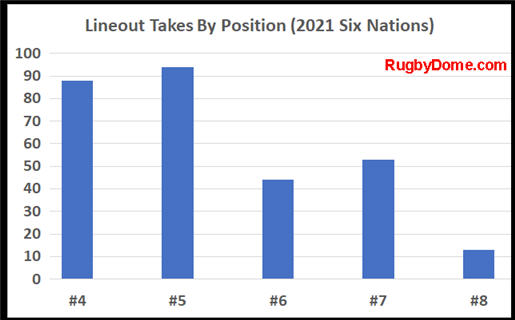Hookers throw into the lineout because they tend to be the shortest forwards on the team and are therefore not used to jump to catch the ball.
As they tend to be stronger than backs, they are also more effective in throwing into the lineout and being in position to join rolling mauls.
These days, all professional rugby teams use the hooker to throw into the lineout.
However, this is not mandatory. Any player can throw in the ball. In fact, scrumhalves or wingers used to be the lineout throwers in older times.
I’ll go through the history of who threw in the ball in later sections of this article. But first, I want to explain why the sport evolved to choose the hooker as the best position for this task.
Why Doesn’t A Different Forward Throw Into The Lineout?
Locks are the tallest players on the field and are needed for jumping in the lineout.
Our breakdown of jumping stats in the 2021 Six Nations showed that locks jump to catch over half of all lineout throws.

Flankers catch nearly a third of lineouts, while the number eight accounts for most of the rest of catches.
This is mainly due to the average heights of rugby players.
Why don’t props throw in?
The shortest and heaviest forwards tend to be in the front row, which means it makes sense for one of the three positions to do the throwing. But why doesn’t one of the props do it?
Props are typically the strongest players on the field. This means they are needed for lifting jumpers in the lineout.
That leaves the hooker as the last forward standing…umm…throwing.
Okay, so we’ve explained the reasons why other forwards don’t throw in. But what about those lazy backs?

Why Don’t Backs Throw Into The Lineout?
You’ll see later that scrumhalves and wingers used to throw into the lineout up to the 1970s and 1980s.
So, why did they stop doing so? There are several reasons.
In earlier times, the lineout tended to end with forwards trying to move the ball a few yards. It made sense for the nearest winger to throw in the ball because he wasn’t going to see it again for a while!
But the sport changed to using lineouts for launching wide attacking plays. The blindside winger could be launched up the centre of the field, or go on an arcing run to support the winger on the opposite side.
This is one reason why coaches didn’t want the wingers starting on the touchline.
Rolling mauls
But the reasons weren’t all about attacking flair. Rolling mauls used to be illegal. But when they arrived into the sport, a small winger wasn’t of much use at the back of the pack.
Instead, a forward throwing in and then joining the back of the maul was far more effective.
Problems with training
There was a third big reason for taking the task away from the scrumhalf and winger. Whichever player had the role would have to join the forwards for many training sessions.
Forwards and backs tend to train at the same time in different parts of the field. Losing both wings or a scrumhalf from the backs training sessions was a significant obstacle to rehearsing attacking plays.

1850s-1940s – Scrumhalf Throwing Into The Lineout
Back in the early days of the sport, there were more than fifteen players on a rugby team.
In the late 19th century, teams played with two scrumhalves on either side of the scrum. Most teams used one of these two players to throw into the scrum.
Of course, there were exceptions. When the All Blacks toured Britain in 1905, they only used one scrumhalf on the field.
The innovative tourists wanted their one scrumhalf to be ready to take the ball from a lineout jumper and initiate an attacking play. So, they used one of the front row players to throw into the scrum.
By the early twentieth century, the rules of the sport had reduced the number of players to fifteen.
Despite the example of the touring All Blacks, the European teams continued to use their scrumhalf as lineout thrower up to the late 1940s.
1950s – Winger Throwing Into The Lineout
By the late 1940s and early 1950s, wingers were increasingly used to throw into the lineout.
Teams used the blindside winger i.e. whichever wing was nearest to the touchline. That meant that two players had to practice their throw.
Two types of throws were in vogue at the time.
Some used a low throw, starting from between the legs. This was more likely to be seen at club level in lower divisions.
Wingers at international or elite club level tended to use a single-handed overarm throw. Think of lobbing a hand-grenade or bowling a cricket ball upward!
Want to see an example?
This is from the classic 1973 match between the Barbarians and the All Blacks. The BaaBaas used their hooker to throw into the lineout, but the All Blacks used the nearest winger.
The clip starts at the point where All Blacks winger Bryan Williams is throwing in the ball to the lineout. Both teams used a single-handed overarm throw.
What about the French?
Some fans have collections of DVDs of older matches. One such fan reported on a forum that he checked what the French were doing in certain years.
They used the winger in these matches in his possession:
- 1958
- 1961
- 1964
- 1968
- 1971
Interestingly, the French switched to using the hooker in 1973. That’s the same year that we know that the All Blacks were using the winger.
But they switched back to a winger in a match in 1979.
1960s – Transitioning From Winger To Hooker
Back in the late 1950s, the set-piece was becoming more important in the northern hemisphere for launching attacking plays.
This meant that teams wanted their wingers to be available at the end of moves. Having them throw in the ball was not ideal.
So, most teams switched to using one of the shortest forwards for lineout throwing. After all, you want your taller forwards available for jumping.
That means picking from the front row. The props were likely to be fatigued from scrummaging, so the hooker got the job.
The French are usually different
Through the 1980s, most teams throughout the world were using the hooker.
As usual, the French did their own sweet thing. Béziers was the dominant French club team through the 1970s and early 1980s. And Bézier used their scrumhalf to throw in the ball.
That meant that the French national team followed suit.
As recently as the 1987 World Cup, France used their scrumhalf to throw into the lineout. That was the Pierre Berbezier, who is now a coach.
What about elsewhere?
An older Springbok fan confirmed to me that nines were also used in South Africa for a period, before they switched to using the hooker.